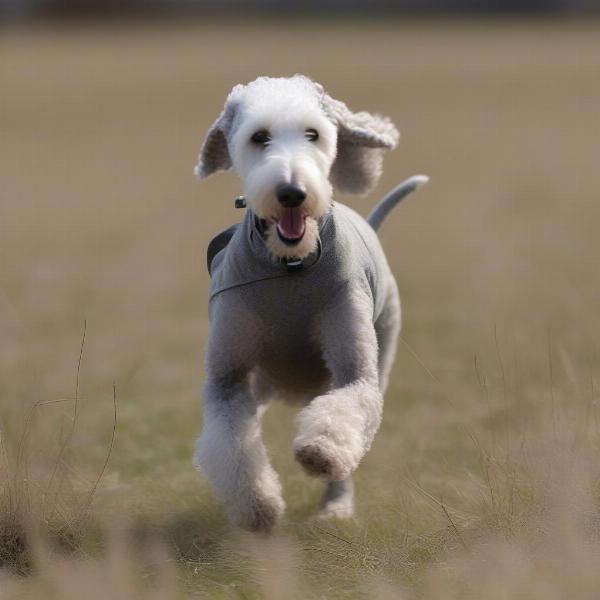The Bedlington Terrier, with its lamb-like appearance, often raises eyebrows when discussed as a “working dog.” While their cuddly looks might deceive, Bedlingtons possess a surprising history rooted in hard work. This article delves into the truth about the Bedlington Terrier as a working dog, exploring its past, present capabilities, and whether this breed fits the “working dog” label in today’s world.
 Bedlington Terrier working in a field
Bedlington Terrier working in a field
A Look Back: The Bedlington’s Working Roots
Originally bred in the Northumberland mining district of England, the Bedlington Terrier, far from being a pampered pet, was a vital asset to the working class. These tenacious terriers were adept at controlling vermin in the mines and homes, protecting families, and even participating in less savory activities like dog fighting and poaching. Their speed, agility, and courageous nature made them ideal for these tasks. It’s this heritage that cemented their place as a true working breed.
The Modern Bedlington: Work Ethic and Capabilities
While their primary role has shifted from mine worker to companion, the Bedlington Terrier retains much of its ancestral work ethic. Their intelligence and eagerness to please make them trainable, although their independent streak sometimes requires a patient and consistent approach. Today, Bedlingtons excel in various canine sports like agility, flyball, and lure coursing, demonstrating their athleticism and drive.
Is the Bedlington Terrier a Working Dog Today?
This question elicits varied opinions. While not typically considered a working dog in the traditional sense like a German Shepherd or Border Collie, the Bedlington’s history and inherent capabilities suggest otherwise. Their working roots are undeniable, and their continued success in canine sports showcases their enduring work ethic. However, their sensitive nature and lower tolerance for harsh conditions mean they’re not suited for all working roles. It’s more accurate to categorize the modern Bedlington as a versatile breed capable of both companionship and certain working activities.
What Kind of “Work” Can a Bedlington Do?
Beyond the aforementioned canine sports, Bedlingtons can thrive in activities like therapy work, where their gentle nature shines. They can also be trained for scent work, utilizing their keen sense of smell. Ultimately, the type of “work” a Bedlington can do depends on the individual dog’s temperament and the owner’s commitment to training.
Choosing a Bedlington Terrier: Consider Your Lifestyle
If you’re considering a Bedlington Terrier, understanding their working background is crucial. While they make wonderful companions, their energy levels and intelligence require outlets. Providing sufficient physical and mental stimulation is essential for a happy and well-adjusted Bedlington. If you’re an active individual or family willing to dedicate time to training and activities, a Bedlington Terrier can be a rewarding and loving addition to your life.
Conclusion
The Bedlington Terrier’s journey from working-class hero to beloved companion is a testament to its adaptability and enduring spirit. While their role in society has evolved, the Bedlington Terrier remains a capable and intelligent breed, retaining much of its working dog heritage. By understanding their history and needs, you can provide the best possible life for this unique and fascinating breed.
FAQ
- Are Bedlington Terriers good family dogs? Yes, they can be excellent family dogs with proper socialization and training.
- Do Bedlington Terriers require a lot of exercise? They need moderate exercise and mental stimulation.
- Are Bedlington Terriers easy to train? They are intelligent but can be independent, requiring consistent and positive reinforcement.
- What health problems are common in Bedlington Terriers? Copper Toxicosis is a breed-specific health concern.
- Are Bedlington Terriers hypoallergenic? While no dog is truly hypoallergenic, their coat sheds minimally.
- Do Bedlington Terriers bark a lot? They are not known for excessive barking.
- How long do Bedlington Terriers live? Their average lifespan is 12-16 years.
ILM Dog: Your Trusted Source for Dog Care
ILM Dog (https://ilmdog.com) is your one-stop destination for comprehensive dog care information. We provide expert advice on various aspects of dog ownership, including breed selection, health, training, nutrition, and grooming. Whether you’re a new dog owner or a seasoned enthusiast, we offer valuable insights to help you provide the best possible care for your canine companion. For expert advice, contact us at [email protected] or +44 20-3965-8624.